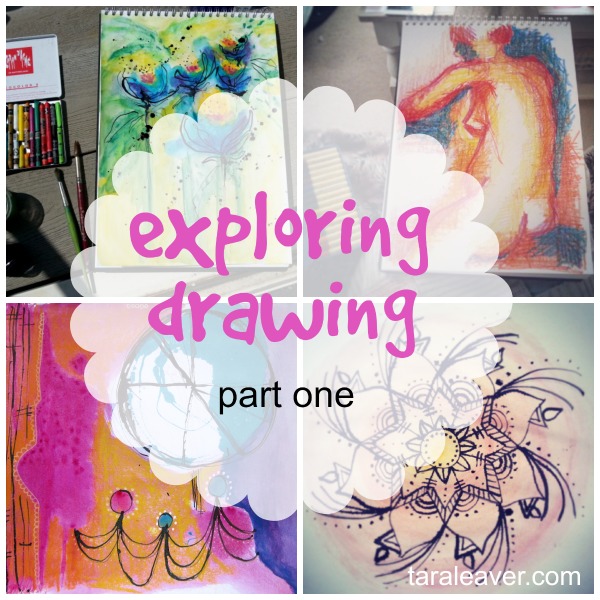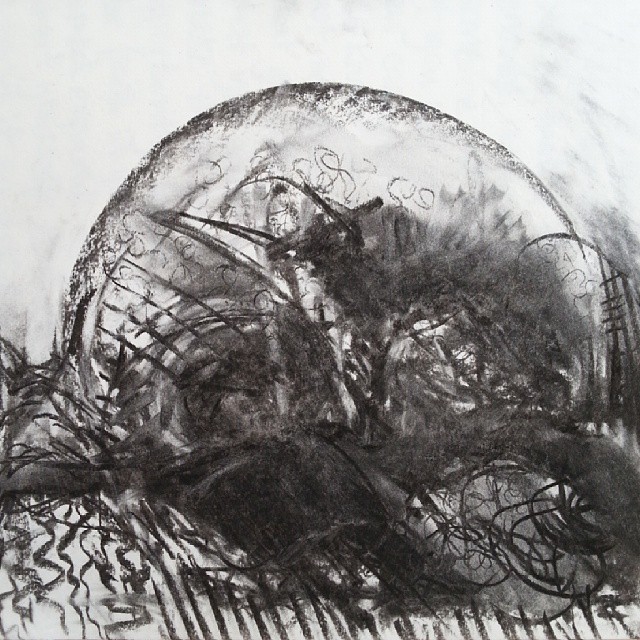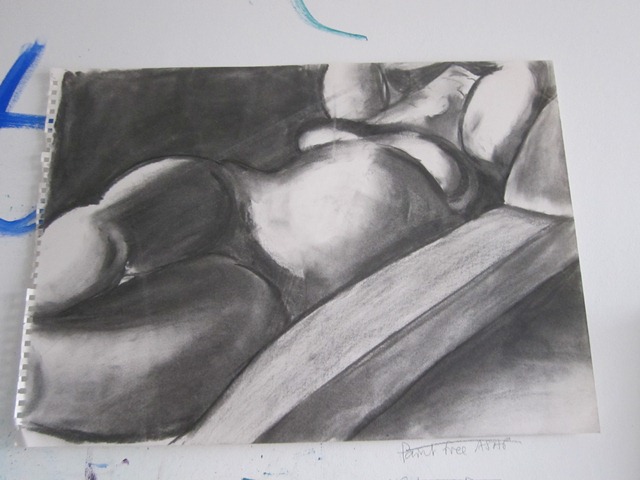{This is the first of a two part series looking at ways to approach drawing.}
What’s your favourite way to draw? Do you love drawing or do you find yourself avoiding it? Do you favour a particular drawing style?
I want to talk about drawing today because I both love drawing and avoid it, and because I’m always interested in finding ways to make art that are not just fun and satisfying, but that also express our uniqueness.
You may know that my favourite way to draw is blind contour drawing.
I recently received an email from a reader {thank you Graham!} who is keen to begin illustrating his own children’s books, and it got me thinking about different approaches to drawing and how we can really root into our own unique way of doing it.
So often we think we have to be some kind of master draughtsman to be able – or even ‘allowed’ – to put pencil to paper.
I have often heard people say, ‘oh I can’t even draw a stick figure’, or ‘I can’t do art because I can’t draw’.
To which I say {with great love and respect}; Nonsense! 😉
Drawing is fun, playful, infinitely expressive, and as far as I’m concerned nothing to to do with stick figures, unless you want it to be.
Here is a brief list of approaches to drawing ~ what are you inspired to try?
blind contour drawing
Easy, fun, meditative, creates unexpected results and can be a nice lead into abstraction.

Buddha :: mixed media on paper :: 19x25cm :: created using my favourite method – blind contour drawing
I also think it’s a great place to start if you’re new to drawing or not feeling too confident about it, because the method of not looking at what your hand is doing means you actively can’t control the outcome.
So no room for pesky perfectionism.
Look at the work of Egon Schiele, who often used this technique. His line work is instantly recognisable; expressive, ‘wobbly’ and distinctive.
Also evidence, should it be required, that this type of drawing can be art in and of itself, or as part of a greater painting, and not just a loosening up exercise.
intuitive drawing
A huge area that covers lots of lovely things like:
- drawing mandalas {Andrea wrote a great little tutorial on that here}
- using drawing as a means of uncovering your personal symbolism
- expressing feelings that do not readily lend themselves to words
….to name just three.
Doodling comes under this heading too; for quirky character drawing inspired by doodles I recommend Carla Sonheim.
Also take a look at Cy Twombly for fabulously expressive scribbly drawing. This approach can be very cathartic.
life drawing
Another great love of mine, although I haven’t done it for a while in a live setting.
There are several websites that offer images of models in life drawing class poses, like this.
I don’t think there’s a substitute for having a living model in front of you, but if you can’t get to a class these can be useful and great practice.
realism

Very occasionally I like to make very detailed drawings like this, but it’s not my most natural or favoured approach.
If you’re looking for lessons in how to make realistic art here, I’m afraid you’re on the wrong website. 😊
While I am hugely admiring of those who can and love to create realistic drawings, and from time to time will copy something as a way to explore a technique or idea, it’s neither where my gifts nor my interests lie.
One thing I will say is that it is always worth learning basic drawing techniques, even if you will only be breaking all the rules later.
A good foundation is always useful. There are thousands of tutorials on YouTube.
Other types of drawing
There are so many kinds of drawing out there, I can pretty much guarantee that there is a way that’s going to interest you, if you haven’t already found it.
Zentangle, animé, cartoon and caricature, graffiti style, lettering, whimsical, simple and minimal, detailed and intricate, children’s book illustration, to name a very few.
Some artists with unique and recognisable drawing styles
Next week I’ll talk more about how we can really begin to dig in and find out what our unique drawing style is.
In the meantime, tell me about your drawing! Do you love it? What’s your style? What would you like to try? Who are your favourite artists who draw?










i lovelovelove blind contour drawing.
i am remembering.
tomorrow i will do…
Yay! I would love to see, if you do!
Thank you for this great summary of drawing techniques 😉 Although art is my business, I am not a trained artist.
I love to hear about new ways of approaching art. So, I will have a go and see how it influences my business 😉 I learned about Point Zero art recently by Michele Cassou, do you know of her?
Hi Lisa – I have ‘Life, Paint and Passion’ by Michele Cassou {and Stewart Cubley} but don’t know about Point Zero art. Very intrigued though! Will look it up.
TARA …CREO QUE MI TIPO DE DIBUJO ES EL SUBREALISTA .
TARA SERA MI MODELO E INICIARE CON TU ROSTRO LA TECNICA SERA A LAPIZ Y DEJARE VOLAR MI IMAGINACION.
SALUDOS DESDE MEXICO .
TARA
Hi Tara, I am a newbie to finding your site. Although I am turning 70 this year my need to create still bubbles in my mind. I am a frustrated ‘ would be if I could be ‘. My husband tells me my mind is like a washing machine ! Going round and round with visions and ideas of stretching creative thoughts. The only way I seem to be able to draw is using a computer program allowing me to, via the mouse, draw and manipulate ( often starting with circles ) to break and reform shapes until I worry it all into the image I am seeing. We ran a successful small business ( until we retired ) with me creating this way in a range of whimsical, often animal, people, etc designs. Now I would love to learn how to free up and expand the way I do this and more.
Hi Terri – I can absolutely relate to the mental washing machine! Sounds like you’ve found a way to make art that you love.
Thank you so much for taking time to reply Tara, I am hoping to learn from your advise a different way to do what I need to do in order to draw. I no longer have access to be relying on the computer as my means to draw.
I have so many ideas but not the skills to implement.
Well for me there’s something deliciously tactile and earthy about using the ‘raw materials’ so to speak! I’ll be releasing a charcoal course soon, and there are various posts about drawing – you can use the search box to find more!
I love contour drawing – but I don’t keep my pencil on the paper all the time so my result is much more impressionistic than yours. While I love my way of doing it, I’m interested to try yours, too!
Another way I like to draw is by doing what I call ‘loopy drawing’. This is where I put a pencil or whatever lightly onto the paper and while looking at the object or scene, just feel my way vaguely around the structure of it, without worrying at all about getting it “right. I end up with a image that looks like someone wound wool around the object in a very messy way. Then I use the rubber end of a pencil to crosshatch-rub-out most of the drawing and then start drawing it again on top of the remnants of the loops. I’ve now got a guide and a real feel for the thing I’m drawing so I’m ready to look properly at what’s in front of me.
That sounds so fun! And like an interesting way to build a drawing or painting. I especially like what you said about rubbing some of it out – that must leave lots of interesting layers and texture.